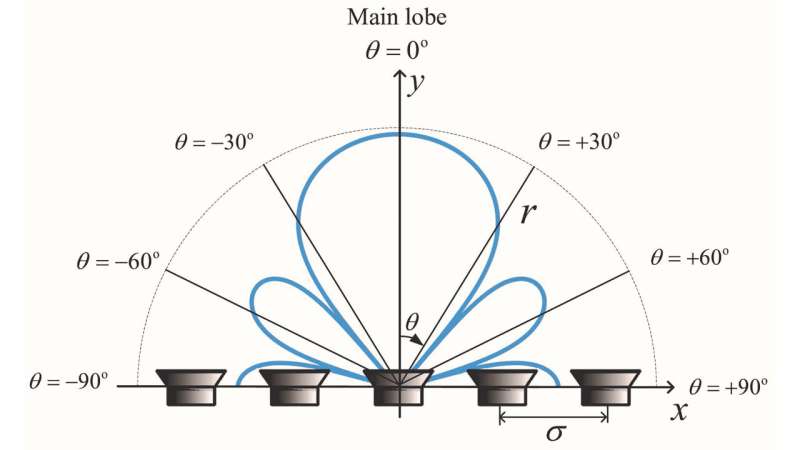A compact speaker system designed to maximize the amount of sound moving toward zero degrees and minimize the sound leakage elsewhere. Credit: Wang et al.
As electronic devices decrease in size, their component parts, like speakers, need to shrink as well.
In JASA Express Letters, published by the Acoustical Society of America, researchers from Northwestern Polytechnical University in China and the University of Quebec developed three designs for compact speaker systems that control the direction of sound more efficiently than previous models.
Single speakers radiate sound waves in every direction. However, for an effective loudspeaker system, sound needs to be focused in one direction, much like the light beam from a flashlight in a dark room. The directivity factor measures how much sound is released in the desired direction compared to other wasted directions.
"We want the beam to have as high a directivity factor as possible," said author Jingdong Chen. "Or in other words, we want the beam to be sharp enough that we can direct the energy only towards certain directions."
For each individual speaker, the scientists were able to manipulate the timing and strength of the outgoing sound waves. They combined multiple speakers together into an array and used the constructive and destructive interference of sound waves to their advantage.
Sound waves canceled each other out in the unwanted directions, while carrying the sound energy efficiently in the desired direction. This boosted the directivity factor in the speaker system designs.
The team found the more speakers they combined in the array, the higher the directivity factor rose.
"This is something that we want to have, but of course, we have to pay a price," said Chen. "We have to increase the size of the array by using more loudspeakers."
The speaker arrays also need to perform equally well at all frequencies to prevent sound distortion.
In their three system designs, the authors optimized different aspects of the speakers. The first achieves the desired direction of the sound waves very well but at a low efficiency. The second maximizes efficiency, but the array does not perform uniformly over all frequencies, leading to sound distortion. The final design is efficient and consistent but may have a lower directivity factor than the other two.
When used in future technologies and research, these designs will allow the user to choose what factors are most important in their speaker system: size, efficiency, directivity, and lack of distortion.
More information: "On the design of differential loudspeaker arrays with broadside radiation patterns" JASA Express Letters, aip.scitation.org/doi/full/10.1121/10.0005760
Provided by American Institute of Physics
























